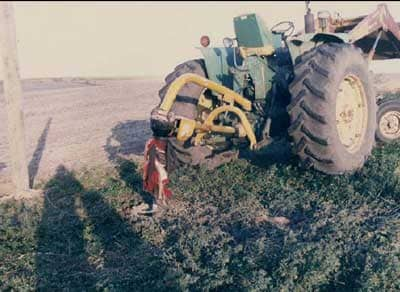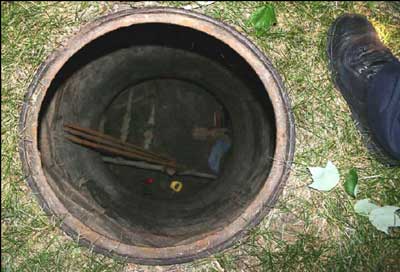Farmer Fatally Injured in Tractor Posthole Auger Entanglement
Iowa Case Report: 05IA075
Report Date: March 07 2007
Summary
A 35-year-old, male farmer was fatally injured while operating a tractor PTO (power take-off) powered posthole auger. The incident occurred in central Iowa late in the fall of 2005. The victim was working alone in an alfalfa field near his farm home, digging post holes for a fence line (Photo 1). The incident was discovered early the next morning when a neighbor drove by and noticed the stationary tractor with its engine running and no operator in sight. The victim was found about 30 feet (10 m) from the tractor. The posthole auger was still turning about 2 feet (0.6 m) deep in its hole in the ground. Loose dirt at ground level around the auger had been spread away from where the auger entered the ground. A shovel with a broken handle was found at the site and a loose strand of barbed wire snaked along the ground between the tractor and auger. The victim’s shirts were wrapped around the top of the auger. There was no guard in place in this area where the auger connects to the gearbox output shaft. The incident resulted in amputation of the victim’s right arm and multiple blunt force wounds. He was dead when neighbors found him.

|
|
Photo 1 – Tractor shown with three-point hitch, PTO-powered posthole digger attachment as it was found early in the morning after the incident.
|
RECOMMENDATIONS based on our investigation are as follows:
- Tractor operators should disengage drive elements and shutoff the tractor’s engine before leaving the operator’s station.
- Operators, and others, should stay clear when the posthole digger is in operation.
- Posthole auger drive elements should be guarded with all shielding in place and functional.
- Work areas should be clear of slip, trip, and fall hazards.
Introduction
Late in the fall of 2005, a 35-year-old, male farmer was fatally injured while operating a PTO powered posthole digger attached to his tractor. The Iowa FACE program learned about his death from a newspaper article and initiated an investigation. The incident was not witnessed and Iowa FACE staff did not conduct an onsite investigation. Incident investigation reports from the County Sheriff’s office and the Medical Examiner were obtained for review. Photographs of the incident scene taken by County Sheriff’s personnel contributed to this report. Other sources of information included interviews with parents, and neighbors who were among those first on the scene.
Investigation
The victim owned and operated his small farm in addition to working for a local farmer. He had purchased his acreage 2 ½ years before the incident, lived there alone, and worked on it nights, weekends, and holidays. This was described as the first fence he would have built on his own. He borrowed the posthole auger from his employer’s farm. He had learned how to build a sturdy, tight, straight fence at home and while doing part-time work for local farmers since the age of 13.
He was operating an older model tractor with an open operator station and no rollover protective structure (ROPS). The tractor had a front-end loader mounted to its frame and a PTO-powered posthole digger attached to the three-point hitch at the rear of the tractor. The incident occurred in an alfalfa field near his farm residence. Next to this alfalfa field was a soybean field which had been harvested earlier in the fall. A utility pole was set in the ground along the line where these fields met. The victim positioned the tractor and posthole auger about 7 feet (2.1 m) into the alfalfa field from this utility pole to set another post (a brace post). A brace (often another post) could be placed between the base of the brace post and the top of the corner post to keep the corner post from being pulled over by the tension in the wires of the fence as it was being built and afterward.
The incident was discovered early in the morning after it happened. A neighbor was driving home from work when she noticed the tractor and posthole digger running without anyone near it. She turned into the field then decided to get her husband before going any further. She returned about 15 minutes later with her husband, who found the victim. The husband shutoff the tractor, covered the body, and notified authorities. Paramedics were at the scene when County Sheriff’s personnel arrived. They determined that the farmer was deceased. It was surmised that the incident occurred early the previous evening since neither the tractor headlights nor its rear work light were turned on when the tractor was found.
The incident was not witnessed and the details surrounding this fatal entanglement are not known. The tractor was found running and the posthole digger’s PTO driveline and auger were rotating. The auger, which had penetrated about 2 feet (0.6 m) into the ground, continued to turn in the empty hole. There was clothing along with body tissue wrapped around the upper portion of the auger in the area below the gearbox. The victim’s severed right arm was discovered next to the posthole digger. His body was found about 30 feet (10 m) rearward from the tractor, which was oriented toward the north and pointed up a slight grade.
The victim was building a fence and, according to neighbors, had been working on this project for awhile. His parents reported he was in good health and was not taking any medications. He was about half finished digging this particular post hole and was out of the tractor operator’s station with the tractor engine running and the PTO control engaged. This allowed the PTO-driven mechanisms, including the gearbox output shaft and the auger connected to it, to continue rotating.
There was a shovel found at the site. Photographs show dirt spread away from where it would pile up around the rim of the post hole. Conditions were dry across much of Iowa at the time with both topsoil and subsoil moisture levels low or very low. Pulverized, dry dirt would tend to fall back into the hole when the auger was stopped or raised. In softer, wetter soil the auger would pull itself deeper into the ground without additional downward pressure. An operator working too close, applying downward pressure to get the auger to penetrate hard ground, clearing dirt, or doing something else, could lose his balance or otherwise come in contact with moving machinery.
A bolt or shear pin is commonly used to connect the auger to the output shaft of the gearbox. A bolt or pin that is too long or has protrusions could snag clothing, and with the absence of guarding the potential for an entanglement in this area of the posthole auger increases. The victim was wearing jeans, sweatshirt, flannel shirt, and a t-shirt. Frayed or loose work clothes would be more susceptible to being snagged by moving machinery parts. Portions of the victim’s clothing were entangled in the upper part of the rotating auger (Photo 2). His severed right arm was found near the posthole digger. His body was found about 30 feet (10 m) directly south from the rear of the tractor.
 |
|
Photo 2 – Victim’s clothing wrapped around the auger.
|
There was a length of barbed wire on the ground between the auger and the tractor. One end of this span of wire was attached to the utility pole. Most likely this wire was being used as a guide to help position posts and keep the fence line straight.
While it is not known how the shovel or barbed wire factored into the beginning or outcome of this incident, they both appear to have been involved. The loose wire was a potential tripping hazard and could have snagged clothing, although it was not entangled in the auger, and it could have interfered with the use of tools such as the shovel, which was found near the auger with blood on its broken handle.
The posthole digger was several years old and showed some wear. The tractor’s PTO master shield was missing, but the shielding on the driveline from the tractor to the implement gearbox was in place, including the shielding for the connection where the driveline connects to the gearbox input shaft. The connection under the gearbox where the gearbox output shaft attaches to the auger did not have guarding in place.
Cause of Death
The cause of death according to the autopsy was multiple blunt force trauma and other injuries to the head, neck, trunk and extremities.
Recommendations/Discussion
Recommendation #1 Tractor operators should disengage drive elements and shutoff the tractor’s engine before leaving the operator’s station.
Discussion: Tractor operator’s manuals recommend disengaging power to machines, lowering suspended implements to their resting position, engaging parking brake and/or engaging the transmission’s park position, and shutting off the tractor’s engine before leaving the operator’s station. While this recommendation may be less convenient for an operator in some task situations, such as clearing dirt around the rim of a post hole, it is effective in preventing entanglements in moving machinery parts because they are stopped.
Recommendation #2 Operators, and others, should stay clear when the posthole digger is in operation.
Discussion: As the auger digs into the ground, dirt from the post hole starts to accumulate around the rim of the hole. This dirt may need to be moved away from the opening as the hole gets deeper. Operators, other workers, and bystanders may be tempted to clear this dirt away while the auger is running: a dangerous practice. The PTO must be disengaged and the auger stopped before anyone approaches a posthole digger while it is in operation. The unshielded auger and drive elements pose entanglement hazards. A trip, fall, or other inadvertent move could result in entanglement with serious consequences.
Recommendation #3 Posthole auger drive elements should be guarded with all shielding in place and functional.
Discussion: A tractor-powered posthole auger is a relatively inexpensive and common implement for digging holes for fence posts. It is attached to the three-point hitch of a tractor, which raises and lowers the auger. The digger’s auger is powered from the tractor’s power take-off (PTO) through a PTO shaft and a right angle gearbox. This changes the direction of power transmission from horizontal to vertical. The gearbox also reduces the rotational speed of the output shaft to the auger to a third or quarter the speed of the tractor PTO, which typically operates at 540 RPM (revolutions per minute) or 1000 RPM when the tractor engine speed control is set at the rated PTO speed.
Operation of a posthole auger may require removal of dirt from around the hole so loose dirt does not fall back into the hole when the auger is lifted by the three-point hitch. Contact with moving machinery parts such as the auger, couplings, or driveline can lead to an entanglement, especially if guarding is missing, out of position, or not properly maintained. In this incident, there was no guarding around the coupling that connected the gearbox output shaft to the auger.
Recommendation #4 Work areas should be clear of slip, trip, and fall hazards.
Discussion: The presence of the barbed wire introduced additional risks in the work environment. There was a loose length of barbed wire on the ground next to the auger. It was not entangled in the auger. However, its location near where the dirt accumulates suggests a tripping hazard which could contribute to a trip, or a fall, or otherwise coming into contact with moving parts of the posthole auger. Barbed wire could also snag tools, interfering with their movement, and potentially redirect them and their user into contact with the auger.
References
- ASABE Standards. S203: Front and rear power take-off for agricultural tractors. St. Joseph, Michigan: ASABE.
- ASABE Standards. S318: Safety of agricultural field equipment. St. Joseph, Michigan: ASABE.
- ASABE Standards. S354: Safety for farmstead equipment. St. Joseph, Michigan: ASABE.
- ASABE Standards. S493: Guarding for agricultural equipment. St. Joseph, Michigan: ASABE.
- Farm Equipment Manufacturers Association (FEMA). Important safety message for owners / operators of post hole diggersexternal icon. Available at: http://www.farmequip.org/safety/post_hole_digger_safety. Accessed 31 August 2006. (Link updated 3/20/2013)
- Murphy, D.J. Power take-off (PTO) safetyexternal icon. Penn State University. Available in National Agricultural Safety Database at: http://www.nasdonline.org/document/905/d000745/power-take-off-pto-safety.html. Accessed January 2007. (Link updated 10/5/2009)
- USDA 2005. Iowa Crops and Weather. Vol 05:37. Available at: http://www.nass.usda.gov/Statistics_by_State/Iowa/Publications/Crop_Progress_
&_Condition /2005/vol0537.pdf. Accessed January 2007. (Link no longer available 3/26/2009)
Iowa FACE Program
FACE is an occupational fatality investigation and surveillance program of the National Institute for Occupational Safety and Health (NIOSH). In the state of Iowa, The University of Iowa, in conjunction with the Iowa Department of Public Health carries out the FACE program. The NIOSH head office in Morgantown, West Virginia, carries out an intramural FACE program and funds state based programs in Alaska, California, Iowa, Kentucky, Massachusetts, Michigan, Minnesota, Nebraska, New Jersey, New York, Oklahoma, Oregon, Washington, West Virginia, and Wisconsin.
The purpose of FACE is to identify all occupational fatalities in the participating states, conduct in depth investigations on specific types of fatalities, and make recommendations regarding prevention. NIOSH collects this information nationally and publishes reports and Alerts, which are disseminated widely to the involved industries. NIOSH FACE publications are available from the CDC-INFO public information center at 1–800–CDC–INFO (1–800–232–4636).
Iowa FACE publishes case reports, one page Warnings, and articles in trade journals. Most of this information is posted on our web site listed below. Copies of the reports and Warnings are available by contacting our offices in Iowa City, IA.
The Iowa FACE team consists of the following from the University of Iowa: Craig Zwerling, MD, PhD, MPH, Principal Investigator; Wayne Johnson, MD, Chief Investigator; John Lundell, MA, Coordinator; Risto Rautiainen, PhD, Co-Investigator, Martin L. Jones, PhD, CIH, CSP, Co-Investigator, and John Kraemer, PA. From the Office of The State Medical Examiner.
To contact Iowa State FACE program personnel regarding State-based FACE reports, please use information listed on the Contact Sheet on the NIOSH FACE web site Please contact In-house FACE program personnel regarding In-house FACE reports and to gain assistance when State-FACE program personnel cannot be reached.

